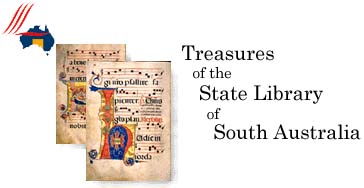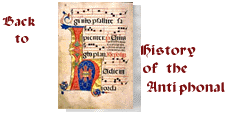
 |
|

MusicThe music is plainsong, or Gregorian chant, written for unaccompanied voices. A sample of a live perfomance by "Flight of Ideas", is available on this site. The content of an antiphoner consisted solely of the sung responses connecting different stages of the service.
The notation symbols for the musical notes are different from
modern notation, and are called neumes, a word deriving from the
Greek neuma, meaning a nod or sign. There are various theories
about the origins of this notation, but one widely held is that
they evolved from the accentuation signs used with Greek and Roman
literature when it was to be declaimed, indicating important points
in the text by marking the rise and fall of the voice.
The settings for the hymns were part of a very old tradition,
originating with St. Ambrose and rendered in Ambrosian chant,
which was simpler than Gregorian. The psalms would have been rendered
at this period in the same plain style, and both were usually
contained in separate manuscript books.
As polyphonal music developed, and church music progressed outside
the monasteries, the settings for the hymns and psalms became
more elaborate, and a number of secular composers created their
own versions which have become individually famous, such as Monteverdi's
setting of Psalm 112, Beatus vir qui timet dominum, and
Handel's setting of Psalm 45, My heart is inditing. |

Copyright and this website | Disclaimer | Privacy | Feedback | Accessibility | Freedom of Information | Last update on 20 December 1997
The URL for this page is http://www.slsa.sa.gov.au/treasures/antiphonal/music.htm